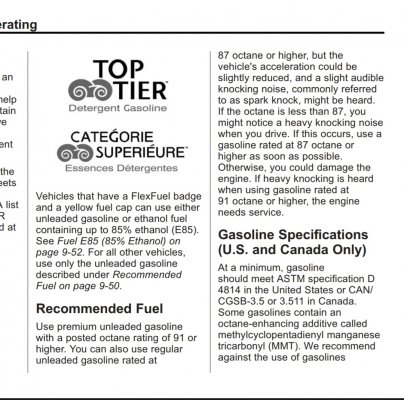Since the LS1 V8, every GM V8 pcm or ecm contains an engine segment with both a high octane spark table and a low octane spark table.
Every GM V8 of 4.8L and 5.3L has a low octane table written specifically with 87 octane in mind.
Same goes for the 6.0L and 6.2L V8s installed in trucks & suvs.
Every single GM V8 will always perform better using 91 or 93 octane.
Also, any naturally aspirated GM V8 will TOLERATE 87 octane just fine.
If you want better performance (including better MpGs) use 91 or 93 regardless.
If you want better performance STILL, step up to an aftermarket tuner who will write your low octane table for 91 and your high octane table for 93 - at which point you better stop using 87 or 89 octane.
Right. GM recommends 91+ and says 87 "is acceptable", but follows that up with something to the effect of "If knocking occurs, use a gasoline rated at 91 octane or higher as soon as possible, otherwise, the engine could be damaged."
I interpret this as "the engine is designed to work in X way, but has safety nets in place should X occur". I'd rather not consistently rely on safety nets.
Maybe I'm overly cautious. But, I don't want ANY knock. The PCM doesn't sample the fuel and proactively adjust. It sees knock, responds and repeats until it has determined that it should stay on the low octane table. The process repeats when it sees a refueling event. I perform best when keeping my bones, blood and dermis covered, as designed. I can TOLERATE getting scrapes and cuts. But, that doesn't mean I was designed to constantly take on such damage, regardless of how small each incident may be.
There are a ton of other factors that affect how "safe" one is running lower octane grades in the 6.2- quality of fuel, driving environment, driving style, etc. Bone stock, my 5.3 would knock on 87 in summertime weather and under moderate acceleration. It was noticeably reduced on 89 and non-existent, even at WOT, on 93. I could run 89 or 87 and drive like I'm 90 years old. But, I prefer the freedom of flooring it whenever I please. In my parts, there are always times where maximum throttle is needed to pass someone or to avoid a potentially dangerous situation. Which, they're often one and the same, as when merging onto the highway.

